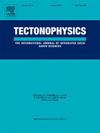Hydration and petrologic changes of inner portions of the subducting oceanic lithosphere facilitated by intermediate-depth faulting
IF 2.6
3区 地球科学
Q2 GEOCHEMISTRY & GEOPHYSICS
引用次数: 0
Abstract
The subduction-zone rheology and seismic behaviour of hydrated oceanic slabs have been widely studied, while the unaltered, dry portions of the subducting lithosphere remain less understood despite their role in earthquake generation and slab pull through eclogitization. We present field-based evidence from the ophiolitic Lanzo Massif (Western Alps), a slice of oceanic lithosphere composed of mantle peridotite and small volumes of gabbro which largely escaped hydration and Alpine metamorphism, representing a mechanically rigid block in the subduction complex. At intermediate depths, this dry lithosphere locally developed pseudotachylyte-bearing faults (e.g. the Moncuni locality) and widespread meso- to micro-faults (e.g., the Mt. Arpone locality). At Mt. Arpone, faults offset the gabbroic dykes by several centimetres: they contain sub-micrometric “annealed” ultramafic ultracataclasite of olivine, pyroxene and spinel, locally overgrown by chlorite and orthopyroxene. These features indicate faulting under dry conditions, which produced a tectonic porosity and enabled localized fluid infiltration. This led to discontinuous hydration of peridotite and to the widespread transformation of cataclastic gabbroic plagioclase into high-pressure zoisite-paragonite symplectites. Thermodynamic modelling suggests that plagioclase breakdown during faulting occurred under blueschist-facies conditions. Recent petrological studies show that this reaction is associated to volume reduction and the formation of reactive porosity, making plagioclase the most intensely eclogitized mineral in the studied samples. Trace element analyses reveal that fluid infiltration drove the internal (closed-system) redistribution of fluid-mobile elements. Eclogitization of the Lanzo peridotite and gabbro only occurred where fluids were present, either from limited oceanic hydration, or from subduction-related fluid infiltration through faults and the porosity created by the metamorphic breakdown of gabbroic plagioclase. The Arpone blueschist-facies ultracataclasites may represent seismic structures that did not evolve into frictional melting; they may be the precursors to the earthquake-generating faults that developed at Moncuni.
中深度断裂促进了大洋俯冲岩石圈内部水化和岩石学的变化
含水大洋板块的俯冲带流变学和地震行为已经得到了广泛的研究,而俯冲岩石圈中未发生变化的干燥部分尽管在地震的发生和榴辉岩作用下的板块牵引中发挥了作用,但人们对它们的了解仍然很少。我们从蛇绿质兰佐地块(西阿尔卑斯山)提供了基于野外的证据,这是一片由地幔橄榄岩和少量辉长岩组成的海洋岩石圈,它们在很大程度上逃脱了水化和高山变质作用,代表了俯冲杂岩中的一个机械刚性块体。在中等深度,这一干燥岩石圈局部发育含假碳酸盐岩断层(如Moncuni地区)和广泛的中、微断层(如Mt. Arpone地区)。在Arpone山,断层与辉长岩岩脉相距几厘米:它们含有亚微米级的橄榄石、辉石和尖晶石的“退火”超镁铁质超长石,局部被绿泥石和正辉石覆盖。这些特征表明干燥条件下的断裂作用,产生了构造孔隙,使局部流体渗流成为可能。这导致了橄榄岩的不连续水化作用,并导致碎裂辉长岩斜长石广泛转化为高压辉长石-副长石复合岩。热力学模拟表明,在蓝片岩相条件下,斜长石在断裂过程中发生破裂。最近的岩石学研究表明,这种反应与体积缩小和反应孔隙的形成有关,使斜长石成为研究样品中榴辉化最强烈的矿物。微量元素分析表明,流体入渗驱动流体流动元素的内部(封闭系统)再分布。Lanzo橄榄岩和辉长岩的榴辉化只发生在流体存在的地方,或者是由于有限的海洋水化作用,或者是由于俯冲相关的流体通过断层渗透和辉长斜长石变质破裂产生的孔隙。Arpone蓝片岩相超碎屑岩可能代表未演化为摩擦熔融的地震构造;它们可能是在蒙库尼形成的地震断层的前兆。
本文章由计算机程序翻译,如有差异,请以英文原文为准。
求助全文
约1分钟内获得全文
求助全文
来源期刊

Tectonophysics
地学-地球化学与地球物理
CiteScore
4.90
自引率
6.90%
发文量
300
审稿时长
6 months
期刊介绍:
The prime focus of Tectonophysics will be high-impact original research and reviews in the fields of kinematics, structure, composition, and dynamics of the solid arth at all scales. Tectonophysics particularly encourages submission of papers based on the integration of a multitude of geophysical, geological, geochemical, geodynamic, and geotectonic methods
 求助内容:
求助内容: 应助结果提醒方式:
应助结果提醒方式:


